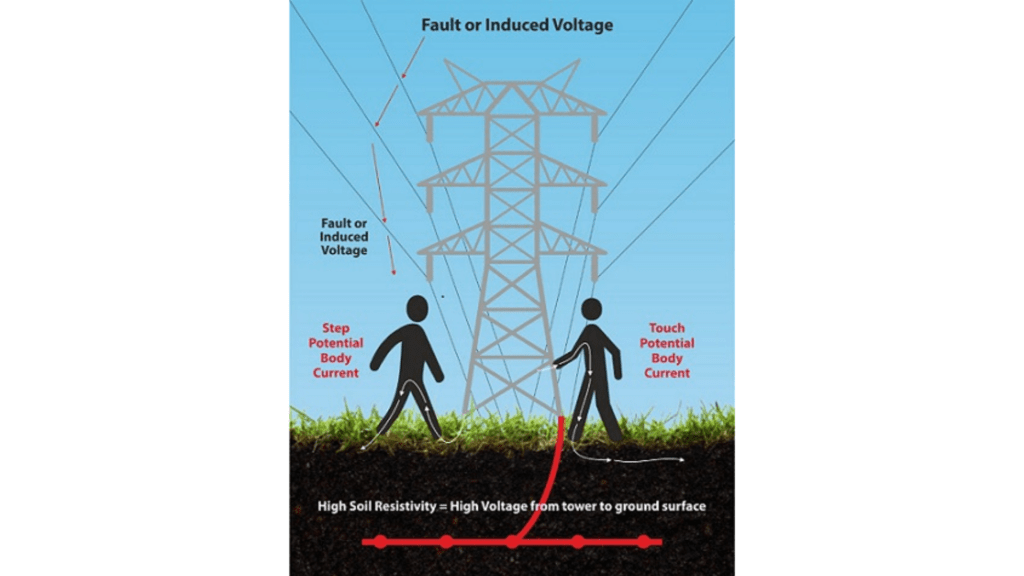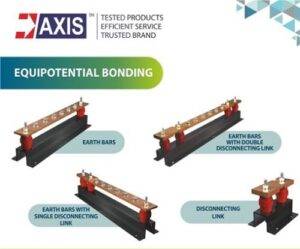To grasp the concept of step and touch potential as per IEC 62305-3 (EN 62305-3) How energy dissipates over conductive objects. Some good conductors exist that provide a path to the ground during broken pole or downed wire conditions, such as metal fences, damp soil, and puddles. Other conductors, such as trees, wood fences, and utility poles, may not be as good as metal conductors but still allow electricity to flow to the ground. Although wood is considered an insulator, damp wood will carry electricity.
The object and nearby vicinity become activated when an energised conductor falls across a chain-link fence or directly to the ground, generating high voltage in proportion to the earth. The voltage is determined by the source, the object’s resistance, and the soil conditions, including substance and moisture.
The ground potential gradient is the voltage dissipation from a grounded conductor – or the grounded end of an electrified grounded item. Ground potentials are voltage decreases related to this dissipation. With increasing distance from the grounded end, the voltage drops fast.
What is Step Potential?
A high-voltage condition is when current flows from an overhead conductor through a chain-link fence to the earth, resulting in a voltage gradient. It is based on the soil resistivity, resulting in a voltage differential – also known as a potential difference – between two sites on the ground.
What is Step Voltage?
The voltage between the feet of a person standing near an electrified earthed object is known as step potential. It’s also equal to the voltage difference determined by the voltage distribution curve between two sites separated by a significant distance from the electrode. Only standing near the connected device puts a person in danger during a fault. A part of the earth potential that can be spanned by a human taking a 1 m step is called step voltage.
The form of the potential gradient area determines the step voltage. The step voltage drops as the distance from the structure increases, as illustrated in the diagram. As a result, the risk to people decreases as they move away from the structure.
The following steps can reduce the step voltage:
- Using barriers or fences to keep people from entering potentially dangerous places.
- The floor resistance should be within 100k for 3m spacing around the down conductor.
- Reducing mesh size of the earthing network for potential control.
What is Touch Potential?
Touch potential is the touch voltage between the live object and the person’s feet in contact. In some circumstances, the contact potential may be virtually equal to the whole voltage across the earthed object. If the object is earthed at a location other than the person’s point of contact with it. A crane, for instance, is earthed to the system neutral. if due to any circumstances the crane comes in contact with the live line, the crane and person sitting inside will be exposed to “touch potential or touch voltage”.
The following steps can reduce the touch voltage:
1) Insulating material (at least 3 mm cross-linked polyethene with an impulse withstand voltage of 100 kV (1.2/50 s) is used to cover the down conductor. The position of the down conductors can be adjusted but should not be altered.
2) Within a radius of 3 m surrounding the down conductors, the contact resistance of the floor layer is not less than 100 k.
3) Note: A 5 cm thick layer of insulating material, such as asphalt (or a 15 cm gravel layer), reduces the danger to a level that is tolerable (IEC 62305-3).
4) Potential control is used for compressing the earth-termination system’s meshed network.
Importance of Potential Control
If a big group of people routinely congregate in an area dangerously close to a structure that needs to be protected, they should be offered control for being safe.
If the resistance gradient on the earth’s surface in the area to be protected does not exceed 1/m, potential control is sufficient. To do this ring earth electrode at a distance of 1 m and a depth of 0.5 m should be added to an existing earth electrode foundation. This is “the first ring” of the potential control if the structure already has an earth-termination system in the form of a ring earth electrode.

If a structure has potential control, the down conductors must be linked to all control rings.

Potential Hazards due to Step and Touch Potential
Step and Touch voltage safety has become the driving criterion for safe Earthing/Grounding Design. Due to recent modifications to BS EN 50522 and IEEE Std.81. an Earlier 1-ohm earth mat ensured safety, but that is no longer the case.
Both IEEE and IEC have accepted best and healthy practices for the given situation. As per the standards, the natural danger created by the rise of the earth potential can be withstood by the human heart or animal, caused by a difference of potential when touching any connected equipment or standing close as per touch or step potential.
How to reduce the risk caused due to Step Potential and Touch Potential?
After identifying the hazards through a Rise of Earth Potential Study, the specialised Electrical Earthing Consultant has access to several vital fundamental measures to decrease the possibility of a step and the risk of a touch (mitigation).
However, knowing how to apply, combine, and arrange these into a reliable electrical earthing solution is difficult. The surface voltages are controlled and maintained such that the heart’s permitted thresholds don’t exceed and are within a budget’s practical financial restrictions.

The top resistivity surface layers should be a supplementary mitigating strategy. For example, the goal of the earthing should be to provide a safe base design when possible, without the use of soil conditioning chemicals or surface layer mitigation.
Touch Voltage on a Lightning Protection System’s Down Conductor
The area at risk of touch and step voltages is within 3 m of the building and has a height of 3 m. The length of this area is equivalent to a person raising their hand to their highest reaching height plus a separating distance.
Measures against impermissibly high touch voltages may be required in the case of exposed structures (structures prone to lightning strikes, that are accessible to the general public (e.g., shelters).

Touch voltage is reduced during lightning protection by taking the following steps:
1) The down conductor is insulated (at least 3 mm cross-linked polyethene with a 100 kV (1.2/50 s) impulse withstand voltage). The position of the down conductors is revised.
2) The earth’s surface layer resistivity must be at least 100 k within 3 m of the down conductor (IEC 62305-3 (EN 62305-3)).
3) Notes or restriction notices can minimise the likelihood of people accumulating. There’s also the potential of encountering roadblocks.
Criteria for the personal safety of human beings against the Step and Touch Potential:
Do not assume that a conductor which has fallen to the ground or not sparking is safe.
It’s a common misconception that all coated, waterproof, or insulated wire is telephone, television, or fibre-optic cable.
Even though low-hanging wires are not contacting the earth, they still contain voltage potential to avoid touching them. Everything is live until it is checked and de-powered.
Do not approach a downed or falling power line. Assume that it is active at all times. It might be fatal if you touch it.
From the point of contact, electricity can flow outward in a circular pattern through the earth. Travelling out from the centre can form voltage discrepancies. It’s never a good idea to drive over power lines. Assume that they’re active. Even if they aren’t, deadlines can coil up in your machinery or vehicle.
If you come into contact with an electrical power line while driving, stay calm and do not exit the vehicle unless it is on fire. If at all feasible, seek assistance.
If you have to escape any equipment due to a fire or other safety concern, try to jump entirely clear, avoiding touching the equipment and the ground at the same moment.
To reduce electric current and avoid electrical shock, land with both feet together and shuffle away in tiny steps. Maintain your balance at all times.
Read more about Earthing & Lightning Protection
Surge Protection Devices (SPD)
Lightning Protection Zones and their Application to SPD Selection
How does a Lightning Arrester work?
Click here to view all of Axis’s Lightning Protection, Lightning Arresters and Earthing products.
Thank you for reading the blog, Axis is a leading manufacturer and supplier of Electrical Components to over 80+ Countries. Talk to our industry expert by visiting our contact us section. You can also watch our videos by our experts – click here.
Follow us on LinkedIn for regular updates on our Products!








